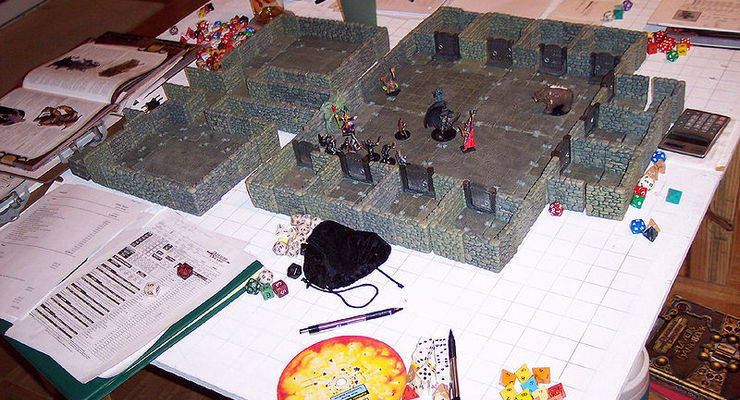
Image of a Dungeons & Dragons in progress. [Phillip Mitchell / Used under Creative Commons License]
The game is commonly recognized as the beginning of modern role-playing games, and departs from traditional wargaming by allowing players to create their own character to play instead of a military formation.
Characters then embark upon imaginary adventures within a fantasy setting.
Players interact with the setting’s inhabitants and each other. In the process, the characters earn points in order to rise in levels, and become increasingly powerful over a series of separate gaming sessions.
For Antero Garcia, Pasadena resident and associate professor of education at Stanford University, the game, long saddled with a reputation as “nerdy,” is actually a powerful tool for building social and emotional skills.
“The good thing about Dungeons and Dragons,” Garcia explained in a recent interview, “is, if you’ve ever seen it, or if you’ve ever played it, it’s a game where you build the world around you through talking and communication, and sometimes dice and maps.”
But instead of a big board, he pointed out, the playing field for Dungeons and Dragons is a 300-page rule book.
Garcia—who specializes in literacy, and recently participated in a workshop by the International Literacy Association—explained, “It is dense, academic reading and writing, and it’s complex material that people willingly want to read. It looks like a textbook. But particularly for young people, they’re able to really dive in really powerful ways.
“Not only is it that young people or adults of all ages are able to just jump into this game and kind of engage with the kind of stuff we want to happen in schools,” Garcia continued, “but it’s also much more than that.

Antero Godina Garcia, Associate Professor of Education, Stanford Graduate School of Education [Photo credit: Stanford University]
In terms of emotional literacy, Garcia explained, the game is “about communicating with each other.”
He introduced the character examples of a fighter and a cleric, characters who would help each other throughout a game.
“We are going to build a relationship in the game for our characters,” Garcia elaborated. “We’re going to pretend that our characters have a certain kind of relationship.
“And we are also going to have a relationship as people sitting at the table and playing the game together,” he added. “And so we’re not only practicing and trying on different relationships and figuring out what emotions we might present and perform with each other, we’re also actually having those relationships with each other in the kind of real world versus the virtual world.
“There’s just a whole lot of emotional wellbeing that can happen within and across tabletop role-playing games like Dungeons and Dragons,” he pointed out.
Not only that, but the rule book itself is written at a higher level than most textbooks, says Garcia.
“I’m sure there is a study of this, that that rule book that we’re talking about is written at a higher level. And yet I’ve played with elementary school kids, and I’ve run games for middle and high school kids. I’ve played games for years with adults. It’s one of those things where if you are interested in something enough, you will find a way to engage with the literacy practice.
“It’s not that school’s too hard, he expanded. “It’s that maybe we’re not necessarily approaching school in the same way as, you know, conquering a dragon or, you know, stealing the loot from, you know, a band of goblins.”
As Garcia concluded, “I think that this idea of ‘How can I understand someone else’s emotions and how can I build up empathy and how can I use complex rule systems?’ is important. Those are all the skills we want in young people today.
“I think we could play D&D and that could be something that’s really powerful in classrooms,” he said. “But I also think taking this ethos of play, this ethos of imagination and redesigning schools from the ground up in that way, is a big step forward.”
Your move, teacher.










